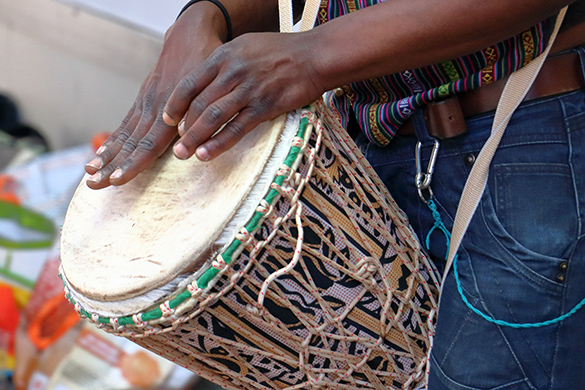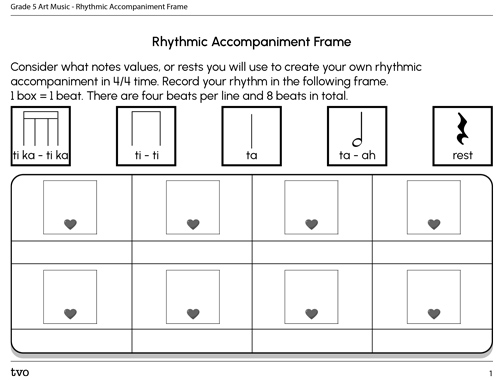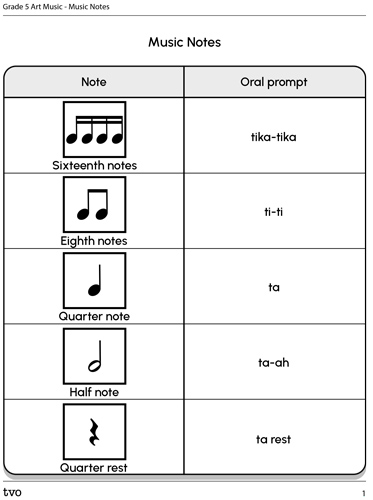Minds On
Today’s vocabulary
Press the following tabs to access today’s vocabulary.
Let’s get started!
Explore the following video entitled “Fanga Alafia” to check out a musical performance.
What kinds of instruments do you notice?
What is the relationship between the melody and the rhythmic parts? Consider the texture of the performance.
Record your ideas using a method of your choice.
Action
Get ready, get set…
Texture is one of the fundamental elements of music.
It describes how layers of sound within a piece of music work together to create the overall effect of a piece of music.
For example, in the Minds On we explored a performance with a melody and rhythmic accompaniment. You may have noticed that the melody was sung, and the accompaniment was played on different instruments to support the melody.
The combination of the different parts helped to engage the audience to dance, move, and sing along to the music.
Let’s return to the performance of Fanga Alafia. Check out the following video entitled “Fanga Alafia” and consider the following question:
How did the musicians create a rhythmic accompaniment?
Press ‘Answer’ to access a possible answer.
The musicians created rhythm patterns using body percussion (e.g., clapping their hands) and various percussion instruments. One of these instruments is the djembe.

The djembe is a West African drum. It is traditionally carved from a single piece of hardwood and topped with an animal skin as a drumhead.
What do you notice about the rhythms the musicians created?
Press ‘Answer’ to access a possible answer.
There are different rhythm patterns which are made up of different note values.
At one point in the performance, the vocal melody ends, and the focus is on the rhythms played on the instruments.
The musicians take turns playing their own rhythms, or solos.
Creating a rhythmic pattern
Imagine you are joining the performance of Fanga Alafia.
How might you add a part to support the performance?

Two teacher characters having a conversation. The first teacher shared: ‘Hey Teacher B, what if we created our own rhythm to add to the performance?’ The second teacher responds: ‘That’s a great idea! What note values should we use?’ The first teacher replies: ‘How about we use ‘ti-ti’ (eighth note) and ‘ta’ (quarter note)?’ The second teacher responds: ‘Sounds great! How about something like this?’ The second teacher shares a musical phrase of 8 beats. The rhythm is ‘ta, tika-tika, ti-ti, ta, ti-ti, tika-tika, ti-ti, ta.” The second teacher shares: ‘We can perform our rhythm using body percussion, instruments or found sounds. In the video performance of “Fanga Alafia”, the musicians clap and play their rhythms. When should we include the rhythm?’ The first teacher responds: “Well, we could include it before the singer begins the vocal melody, or we could add our rhythmic accompaniment after the vocal melody has begun.” The second teacher replies: “Let’s add our part before the vocal melody. We can use it to introduce the song.” The first teacher asks: “Should we repeat it?” The second teacher answers: “Yes, let’s introduce the song with our rhythmic accompaniment. We can play for 4 bars before the vocal line begins. Then, we can continue playing our rhythmic accompaniment through to the end of the song.” The first teacher responds: “Let’s review other notes that can be used to create a rhythmic accompaniment for “Fanga Alafia”. We will be creating using 4/4 time.”
What is 4/4 time?
A time signature of 4/4 means that there are 4 beats in each bar or measure. The notes in each bar of music must add up to four quarter notes.
For instance, a bar could contain the following notes values: eighth note, quarter note, eighth note, quarter note, quarter note. (An eighth note plus an eighth note equals one quarter note.) All these notes’ values add up to create four quarter notes.

Explore the notes in the following Music Notes chart. Each note equals one quarter note. You may practice reading or playing the notes aloud using the words that use the same rhythm.
Access the following audio recording entitled “Music Notes” to learn more about the notes explored in the Music Notes chart.
Music Notes
Go!
It’s your turn to create a rhythmic accompaniment to join the performance of Fanga Alafia.
Your rhythm should be 8 bars in length and include eighth notes and sixteenth notes.
Complete the Rhythmic Accompaniment Frame in your notebook or use the following fillable and printable document. If you would like, you can use speech-to-text or audio recording tools to record your thoughts.

Press the Activity button to access the Rhythmic Accompaniment Frame.
Activity (Open PDF in a new tab)Consolidation
Putting it all together

Now that you have completed your rhythm, describe how you might perform it.
Will you begin your part before the singer begins the vocal melody?
Will you play your rhythm for the whole song or for only parts of it?
Create a detailed description of how you would add it to the vocal melody in Fanga Alafia. If possible, perform it.
Review your learning
Today you learned how to create a rhythmic accompaniment for a song.
Use the following questions to reflect on your learning.
- What is the relationship between the melody and the accompaniment?
- What do you think are some challenges when playing an accompaniment for a song? Brainstorm some strategies to meet these challenges.
- What is something you would like to share about what you did in this lesson? What do you want to continue to practice?
Record your responses digitally, orally, in print, or in a method of your choice.
Reflection
As you read through these descriptions, which sentence best describes how you are feeling about your understanding of this learning activity? Press the button that is beside this sentence.
I feel…
Now, record your ideas using a voice recorder, speech-to-text, or writing tool.
